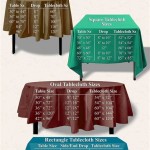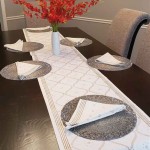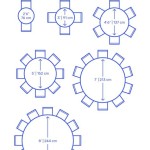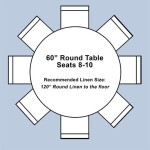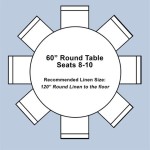How To Make a Table Runner With Backing Paper for Beginners
A table runner is a decorative piece that adds a touch of elegance and personality to your dining table. While you can purchase pre-made table runners, creating your own is a rewarding craft project that allows you to personalize your decor. Using backing paper is a simple and effective method for beginners, as it provides stability and durability to the runner while showcasing the beauty of your chosen fabric.
Choosing Your Materials
Before embarking on your table runner creation, gather the necessary materials. This includes:
- Fabric: Select a fabric that complements your dining table and overall decor. Choose a fabric that is easy to work with, such as cotton, linen, or silk. Consider patterns, colors, and textures that align with your aesthetic.
- Backing Paper: Opt for a heavyweight backing paper that is durable and provides a stable base. Common choices include fusible interfacing or craft paper.
- Scissors: A sharp pair of fabric scissors will ensure clean and precise cuts.
- Sewing Machine: If you plan to sew the backing paper to the fabric, a sewing machine will make the process easier and faster. You can also use fabric glue for a no-sew option.
- Iron: An iron is essential for pressing the fabric and fusing the backing paper, ensuring a smooth and professional finish.
- Measuring Tape: Accurately measure the desired length and width of your table runner to determine the fabric and backing paper dimensions.
Preparing the Fabric and Backing Paper
Once you have gathered all the materials, it's time to prepare the fabric and backing paper. Follow these steps:
- Measure and Cut: Determine the desired length and width of your table runner. Add seam allowances to the measurements if you plan to sew the backing paper to the fabric. Cut both the fabric and backing paper to the desired dimensions.
- Press the Fabric: Iron the fabric to remove any wrinkles or creases. This will help to ensure a smooth and professional finish.
- Fuse the Backing Paper (Optional): If you are using fusible interfacing, follow the manufacturer's instructions to fuse it to the wrong side of the fabric. This step provides additional stability and durability to the table runner.
- Align and Pin (Optional): If you are sewing the backing paper to the fabric, align the edges of both materials and pin them together to secure them in place. This step prevents the fabric from shifting during sewing.
- Hemming: Hem the edges of the table runner for a polished look. This can be achieved by turning the fabric under and stitching it in place or by using a serger to finish the edges.
- Embellishments: Add decorative elements such as ribbon, lace, or beads to enhance the runner's aesthetic. Choose embellishments that complement the fabric and your overall decor.
- Ironing: After completing all the steps, iron the table runner again to ensure a perfectly smooth and professional finish.
Sewing or Gluing the Backing Paper
Depending on your preference and skill level, you can choose between sewing or gluing the backing paper to the fabric. Here's a breakdown of both methods:
Sewing the Backing Paper
If you are sewing the backing paper to the fabric, use a straight stitch along the edges of the runner to create a secure and durable bond. Adjust the stitch length on your sewing machine to match the fabric's thickness. Remember to backstitch at the beginning and end of each seam for added strength.
Gluing the Backing Paper
For a no-sew option, use fabric glue to attach the backing paper to the wrong side of the fabric. Apply a thin layer of glue along the edges of the backing paper and press it firmly onto the fabric. Allow the glue to dry completely before proceeding.
Finishing Touches
After sewing or gluing the backing paper, add some finishing touches to complete your table runner. Consider these options:
Key Points to Remember
Here are some key points to remember when making a table runner with backing paper:
1. Fabric and Backing Paper Choice
Select a fabric and backing paper that are compatible and provide the desired level of stability and durability. Consider the weight and texture of the fabric when choosing the appropriate backing paper. A heavier fabric may require a thicker backing paper to prevent sagging.
2. Seam Allowances
If sewing the backing paper to the fabric, remember to add seam allowances to your measurements. This will ensure that the finished runner is the desired size.
3. Ironing
Ironing is crucial throughout the process to achieve a smooth and professional finish. Iron the fabric before and after sewing or gluing the backing paper.
4. Experimentation
Don't be afraid to experiment with different fabrics, backing papers, and embellishments. The beauty of crafting is the freedom to express your creativity and personalize your projects.

One Hour Table Runner Tutorial Complete Step By Instructions

How To Make A Simple Spring Quilted Table Runner Stone Cottage Home

Pleated Diy Paper Table Runner Beautify Creating Beauty At Home

How To Make A Table Runner Beginner Sewing Projects

How To Make A Short Table Runner I Should Be Mopping The Floor

How To Make A Table Runner 30 Minutes Or Less Patchwork Posse

Pleated Diy Paper Table Runner Beautify Creating Beauty At Home

How To Make A Table Runner Beginner Sewing Projects

How To Sew A Simple Table Runner Through My Front Porch

Make A Patchwork Hexagon Table Runner My Poppet Makes
Related Posts

